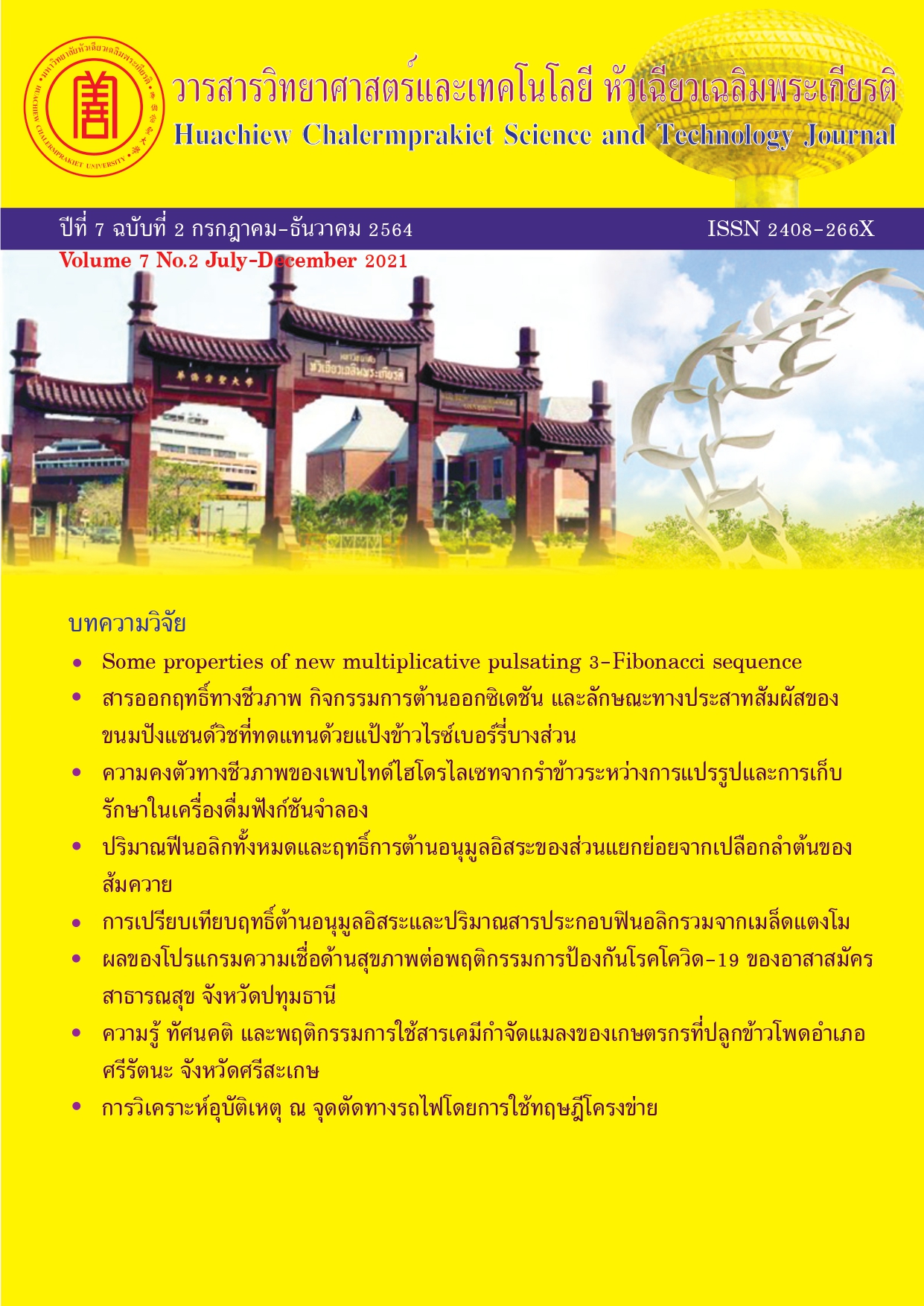Total phenolic contents and antioxidant activities of sub-fractions from stem barks of Garcinia pedunculata
Total phenolic contents and antioxidant activities of sub-fractions from stem barks of Garcinia pedunculata
Keywords:
Antioxidant, Sub-fraction, Column chromatography, Garcinia pedunculata, Total phenolic contentsAbstract
The objective of this research was to compare the antioxidant activity of crude extracts and sub-fractions from the stem bark of Garcinia pedunculata. Six sub-fractions (Fr1-Fr6) were separated from ethyl acetate crude extract of Garcinia pedunculata stem bark using the column chromatography technique by the gradually increasing polarity of the eluent. The antioxidant activities of the ethyl acetate crude extract and six sub-fractions were evaluated using DPPH and ABTS techniques. It was found that, the ethyl acetate crude extract and sub-fractions 1 -3 (Fr1-Fr3) showed IC50 values greater than 100 µg/mL, while sub-fractions 4-6 (Fr4-Fr6) displayed IC50 values in the range of 43.19. -92.49 µg/mL. In addition, the antioxidant activity examined using the ABTS technique exhibited that the ethyl acetate crude extract and sub-fractions 1 -2 (Fr1-Fr2) showed IC50 values greater than 100 µg/mL while sub-fractions 3-6 (Fr3-Fr6) showed IC50 values in the range of 7.71-65.71 ug/mL. Total phenolic compounds of ethyl acetate crude extract and sub-fractions 1-6 (Fr1-Fr6) were ranged from 1.96 to 275.96 mg mgGAE/gDW. The sub-fraction 4 (Fr4) showed the highest antioxidant activities and total phenolic content.
References
Lee J, Koo N, Min DB. Reactive oxygen species, aging, and antioxidative nutraceuticals. Compr Rev Food Sci Food Saf 2004;3(1):21-33.
Buxiang S, Fukuhara M. Effect of co-administration of butylated hydroxytoluene, butylated hydroxy anisole and flavonoid on the activation of mutagens and drugs-metabolizing enzymes in mice. Toxicology 1997;122(1-2):61-72.
Kim SY, Jeong SM, Park WP, Nam KC, Ahn DU, Lee SC. Effect of heating conditions of grape seeds on the antioxidant activity of grape seed extracts. Food Chem 2006;97(3):472-749.
Gardner S, Sidisunth P, Chayamarit K. Forest Trees of Southern Thailand Volume 1 (Acanthaceae to Escalloniaceae). Bangkok: Torch publishing project; 2015.
Sharma A, Joseph GS, Singh RP. Antioxidant and antiplatelet aggregation properties of bark extracts of Garcinia pedunculata and Garcinia cowa. J Food Sci Technol 2014;51(8):1626-31.
Mudoi T, Deka DC, Devi R. In vitro antioxidant activity of Garcinia pedunculata, an indigenous fruit of North Eastern (NE) region of India. Int J Pharmtech Res 2012;4(1):334-42.
Jayaprakasha GK, Negi PS, Jena BS. Antioxidative and antimutagenic activities of the extracts from the rinds of Garcinia pedunculata. Innov Food Sci Emerg Technol 2006;7(3):246-50.
Vo HT, Ngo NTN, Bui TQ, Pham HD, Nguyen LHD. Geranylated tetra oxygenated xanthones from the pericarp of Garcinia pedunculata. Phytochem Lett 2015;13(2):119-22.
Joseph GS, Jayaprakasha GK, Selvi AT, Jena BS, Sakariah KK. Antiaflatoxigenic and antioxidant activities of Garcinia extracts. Int J Food Microbiol 2005;101(2):153-60.
Islam MZ, Hoque MM, Asif SM, Monalisa K. Chemical composition, Antioxidant capacities and storage stability of Citrus macroptera and Garcinia pedunculata fruits. Emir J Food Agric 2015;27(3):275-82.
Zoliansanga, Lalfakzuala R. Antibacterial activity and phytochemical screening of Garcinia pedunculata Roxb. ex Buch. - Ham. fruit extract by HPLC–ESI-MS. J Pure Appl Microbiol 2021;15(4):2183-94.
Biswajit S, Chandra GB. Study of the effect of Garcinia pedunculata fruit pulp on normal and alloxan induced diabetic mice. Res J Chem Environ 2021;25(6):142-7.
Kureshi AA, Hussain T, Mirgal A, Salvi SP, Barua PC, Talukdar M, Beena C, Kar A, Zachariah TJ, Kumar S, Dhanani T, Singh RR, Kumari P. Comparative evaluation of antioxidant properties of extracts of fruit rinds of Garcinia species by in vitro assays. Indian J Hortic 2019;76(2):338-43.
Oliveira AS, Cercato LM, Souza MTS, Melo AJO, Lima BS, Duarte MC, Camargo EA. The ethanol extract of Leonurus sibiricus L. induces antioxidant, antinociceptive and topical anti-inflammatory effects. J Ethnopharmacol 2017;206:144-51.
Zafar S, Jian YQ, Li B, Peng CY, Choudhary MI, Rahman A, Wang W. Antioxidant nature adds further therapeutic value: An updated review on natural xanthones and their glycosides. Dig Chin Med 2019;2(3):166-92.
Rao AVR, Sarma MR, Venkataraman K, Yemul SS. A benzophenone and xanthone with unusual hydroxylation patterns from the heartwood of Garcinia pedunculata. Phytochem 1974;13(7):1241-4.
Vo HT, Nguyen NTT, Maas G, Werz UR, Pham HD, Nguyen LHD. Xanthones from the bark of Garcinia pedunculata. Phytochem Lett 2012;5(4):766-9.
Downloads
Published
How to Cite
Issue
Section
License
บทความทุกบทความที่ได้รับการตีพิมพ์ถือเป็นลิขสิทธิ์ของ คณะวิทยาศาสตร์แฟละเทคโนโลยี มหาวิทยาลัยหัวเฉียวเฉลิมพระเกียรติ



